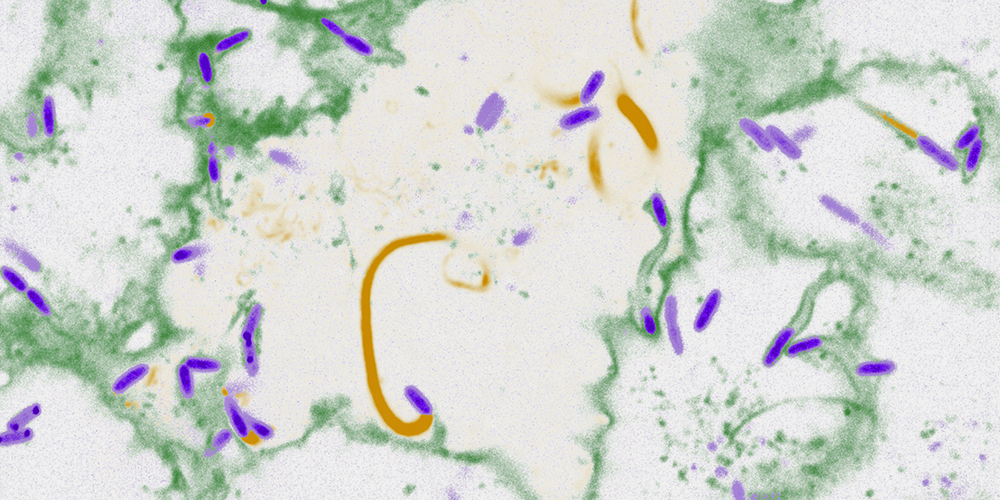The enemy within: How pathogens spread unrecognized in the body
Some pathogens hide inside human cells to enhance their survival. Researchers at the University of Basel, have uncovered a unique tactic certain bacteria use to spread in the body without being detected by the immune system. In their study, they reveal the crucial role of a bacterial nanomachine in this infection process.
22 April 2024 | Katrin Bühler
The inside of a cell provides as a hiding place for various pathogens. By residing in the cell, the bacteria can evade the immune response and spread within the body. Among these invaders are Burkholderia bacteria, including the species B. pseudomallei. This pathogen is known for causing melioidosis, a serious infectious disease prevalent in tropical regions. Due to the high mortality rate and the pathogen’s resistance to many antibiotics, B. pseudomallei is considered a potential biothreat agent.
In the less harmful relative B. thailandensis, the team led by Professor Marek Basler at the Biozentrum, University of Basel, has uncovered a cunning tactic the pathogen uses to spread within the tissue. “The bacteria are equipped with a nano-sized speargun, the so-called type VI secretion system, T6SS for short,” says Basler. “Burkholderia uses this T6SS to move from one cell to another without being recognized by the immune system.” The findings, recently published in the journal Cell Host & Microbe, change the current view of the T6SS’s role in Burkholderia infections.
Pathogen uses nanomachine to spread from cell to cell
From previous studies, it is already known that these intracellular pathogens rely on an unusual spread strategy: After entering the cell, they make use of cellular components, such as actin, to move to the cell membrane and form protrusions into the neighboring cell. Using their T6SS-speargun, the bacteria can also fuse the two cells allowing them to spread.
Unique strategy to spread undetected
By investigating the role of T6SS in more detail, the researchers have discovered a so far unknown and unique escape strategy of these bacteria. “We were surprised to see that Burkholderia can spread not only by inducing cell fusion but also by directly moving from cell to cell,” explains first author Dr. Miro Plum. The detachment of the protrusion from the cell membrane results in the formation of a vacuole within the neighboring cell. The pathogen inside this vacuole then breaks free by utilizing its T6SS to disrupt the surrounding cell membrane.
Surprisingly, spreading this way also enables the bacteria to infect new cells without alarming the immune system. “Normally, infected cells sense invaders by detecting damaged cell membranes, initiating immune responses to eliminate the pathogen,” emphasizes Plum. “However, cells fail to detect T6SS-disrupted membranes.” So, the pathogen remains undetected and can infect new cells.
Exploring the survival tactics of intracellular pathogens
Equipped with the T6SS nanomachine, Burkholderia bacteria can pursue a dual strategy: cell fusion and directly moving from one cell to another. “Our results advance the understanding of infections caused by Burkholderia, particularly its strategies for spreading and immune evasion,” concludes Basler.
The researchers now want to explore the mechanisms that specifically trigger the T6SS assembly in bacteria inside the protrusions to gain deeper insights into the survival tactics of this intracellular pathogen.
Original publication
Miro Thorsten Wilhelm Plum, Hoi Ching Cheung, Patricia Reist Iscar, Yahua Chen, Yunn-Hwen Gan, Marek Basler
Burkholderia thailandensis uses a type VI secretion system to lyse protrusions without triggering host cell responses
Cell Host & Microbe (2024), doi: 10.1016/j.chom.2024.03.013



